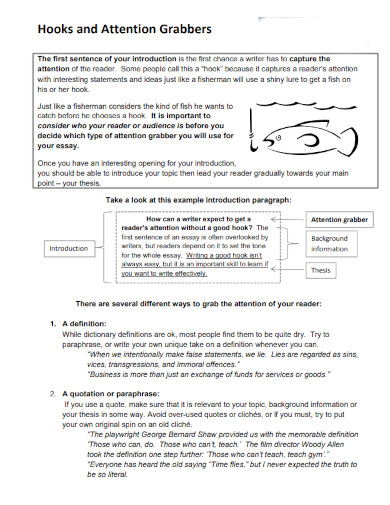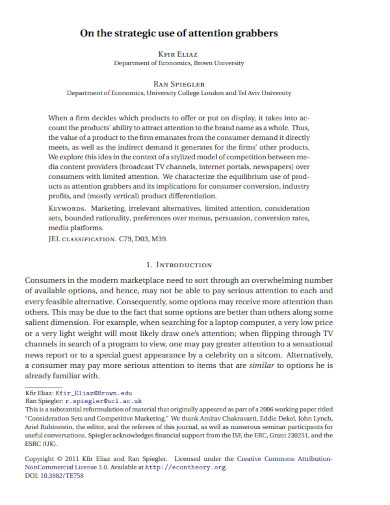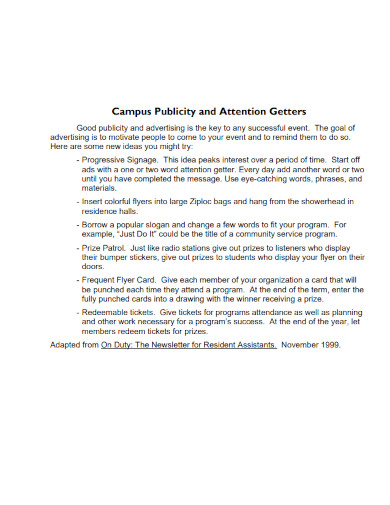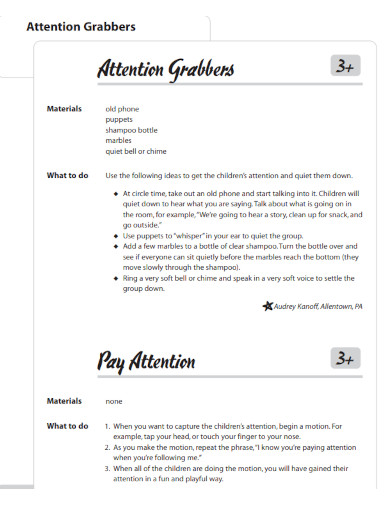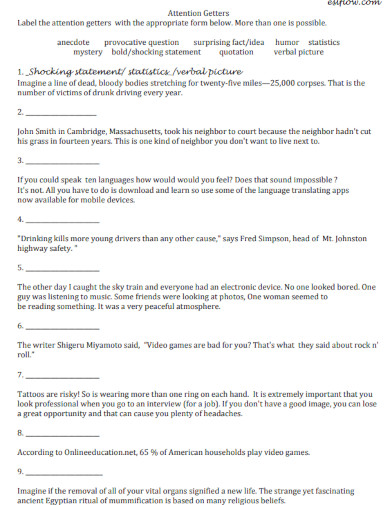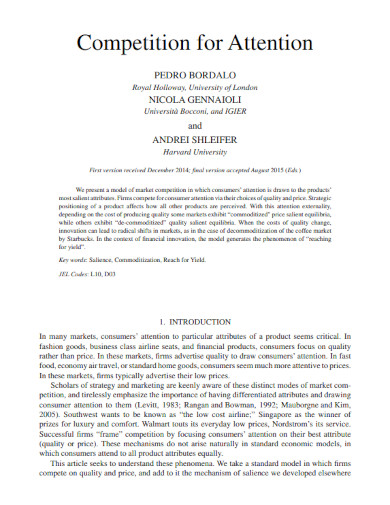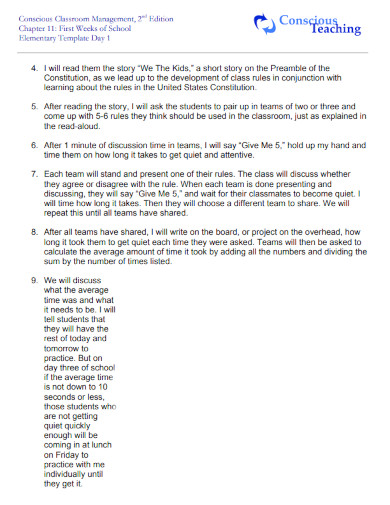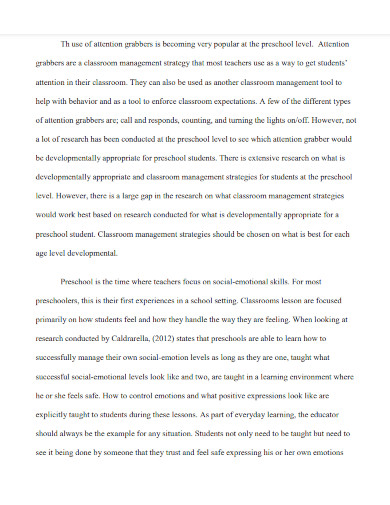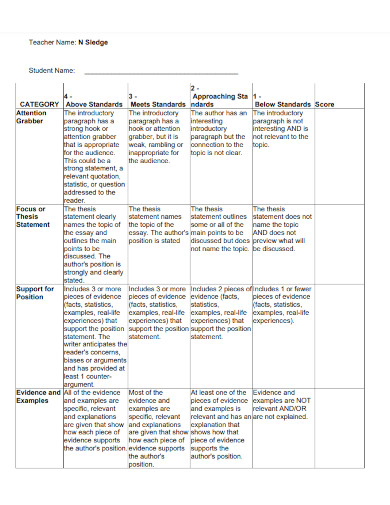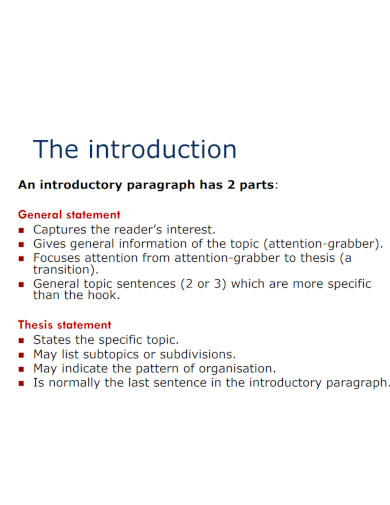10+ Attention Grabbers Examples to Download
An attention grabber, also known as a hook, is a technique used by writers to capture the reader’s interest and draw them into the content. The primary purpose of an attention grabber is to engage the reader’s attention and encourage them to continue reading the piece. Attention grabbers come in various forms, including anecdotes, statistics, rhetorical questions, quotations, and bold statements. The effectiveness of an attention grabber depends on its relevance to the topic, the audience, and the context in which it is used. An attention-grabbing opening can make a significant difference in the success of a written piece by setting the tone, creating interest, and sparking curiosity in the reader.
1. Hooks and Attention Grabbers
2. Strategic use Attention Grabbers
3. Fraud Attention Grabbers Checklist
4. Campus Publicity and Attention Getters
5. Attention Grabber Example
6. Attention Getter Worksheet
7. Competition for Attention Grabbers
8. Getting Attention Conscious Teaching
9. Melody Attention Grabber
10. Attention Grabber Position Paper Rubric
11. Attention Grabber Paragraph
What Is an Attention Grabber
Attention grabbers can come in two definitions. The first definition of an attention grabber relates to a paragraph or a string of words that will reliably obtain and generate the reader’s attention and interest. The second definition of an attention grabber is in the form of something that will grab a person’s attention when observed, usually through various observable and distinguishable signals.
How to Write an Attention Grabber
Strategic usage of the attention grabber or hook can lead to the reader’s increased interest and attention to the text. If you need to have a working reference when you are writing your attention grabber, you may use any of the attention grabber guidelines, worksheets, and rubrics on the links above.
Step 1: Think About What Kind of Text You’re Trying to Write
Each type of text has its format and template the writer has to follow and adhere to. This means that if the text is formal, the writer cannot write or use an attention grabber or hook. For example, if the written text is a qualitative research paper, the introduction should be formal and succinct without any room for an attention grabber or hook.
Step 2: Choose the Attention Grabber or Hook That Suits You Best
There are many types of attention grabbers or hooks you can use on your text. Begin by choosing the preferred type of attention grabber or hook you want to integrate into your text.
Step 3: Outline Your Attention Grabber or Hook
After you have chosen your attention grabber, it is best to create an outline for the attention grabber or hook. The outline will provide a structure that you can follow, which minimizes the chances of writer’s block.
Step 4: Write Your Attention Grabber
When you have finished the steps above, you will then write your attention grabber or hook into your text. Be sure to follow the paragraph structure and format.
Step 5: Let a Reader Test it, Examine the Attention Grabber and Make Changes If Needed
The next step after crafting your attention grabber or hook is to have someone else read it and provide feedback. The success of your attention grabber or hook should then be discussed with the test reader, and changes should be made based on their comments.
[/ns_row]
FAQs
What are examples of attention grabbers in writing?
An attention grabber is a written paragraph that people usually write in the first part of the written output as an introductory paragraph or an introduction. For example, a person can use an anecdotal statement as an introduction to their resume introduction, which will obtain the attention of the hiring manager or HR. Another example of another attention grabber is a question states that the essay or document will answer. The writer or author will always place the attention-grabbing statement or paragraph in the first part of the written output as a way to create an impression and an image while setting the tone of the output’s contents.
Hooks vs. attention grabbers; what is the difference between hooks and attention grabbers?
Hooks is a statement or paragraph that will try to obtain and organically generate the interest of the reader, which will promote said reader to either reread or finish reading the output. Attention grabbers also fill the same role as the hook, which means that both of these terms are the same and interchangeable. It is just that hooks are a more common form of attention grabbers, because it is easier to pronounce, verbalize, and read. Therefore, hooks and attention grabbers refer to the same literary device or technique.
What are examples of non-verbal attention grabbers?
Attention grabbers can also be used outside of writing in the form of non-verbal attention grabbers or attention signals. These actions will usually draw attention to a specific thing or entity, due to their ability to signal a specific organ. But these non-verbal attention grabbers or signals must be observable by any of the five senses, which means a visual attention grabber cannot obtain the attention of someone blind. One can easily see real-life examples of non-verbal attention grabbers or signals in elementary schools, wherein the teacher raises their hand to try and obtain the attention of their student. Another example of a non-verbal attention grabber or signal can be found in the form of a bell on the counter, which will signal the cashier or attendant of the customer’s presence.
Attention grabbers are textual inputs or signals that make an effort to naturally capture the reader’s attention or interest. When utilized well as a literary technique, it may pique the attention of the reader, encouraging them to return to the book or recommend it to others.



